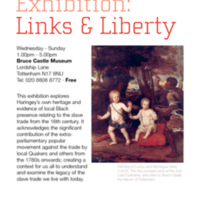
Links and Liberty
An exhibition at Bruce Castle Museum (in partnership with Euroart Studios) explored the transatlantic slave trade, Haringey's heritage relating to the trade and its legacy, and the historic Black presence in the borough from the 16th century onwards. There was a particular focus on the painting of Lucius and Montague Hare, sons of Lord Coleraine (former owner of Bruce Castle), with their African servant. The exhibition also looked at the extra-parliamentary popular movement against the trade by local Quakers such as Priscilla Wakefield and others. Contemporary dance workshops for secondary schools were led by dance company Movement Angol.
The Links and Liberty exhibition included 'Stolen', a life-size installation by artists at Euroart Studios (John Fowler, Lorraine Clarke and Nigel Young) of a section of a slave ship. School pupils were encouraged to climb inside to imagine conditions on board.
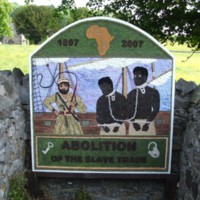
Well Dressings in Derbyshire
Well Dressing is an ancient custom unique to Derbyshire. Each year, between May and September, hundreds of well dressings are created by volunteers in Derbyshire villages. According to many sources, it developed from a pagan tradition of making sacrifice to the Gods of wells and springs to ensure a continued supply of fresh water. In the Derbyshire tradition, pictures are made for the most part of individual flower petals pressed onto clay covered boards. In 2007, many wells were dressed to mark the bicentenary. Pictured are wells in Ashford-in-the-Water, Belper, Tissington and Wirksworth, photographed by Glyn Williams.
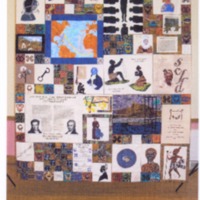
In Stitches
The In Stitches project was led by the African Families Foundation (TAFF) and brought together British, African and African-Caribbean women's quilting groups meeting in London, Liverpool, Bristol, Manchester and Birmingham. The In Stitches Quilt, designed by Janice Gunner, included 60 squares of embroidered images, texts and symbols, depicting historic figures, scenes and artefacts associated with the transatlantic slave trade and its abolition. The Quilt used several of the Adinkra symbols from Africa, originally printed on fabrics worn at funerals by the Akan peoples of Ghana. The accompanying work pack was designed to support learning about slavery based on the four themes of the Quilt: Capture, the Middle Passage, Life in the 'New World', and Proscription of Slavery. The Quilt was unveiled at City Hall in London, and then toured to the British Empire and Commonwealth Museum (Bristol), Central Library (Liverpool), Soho House (Birmingham), the International Quilt Festival (Birmingham) and Central Library (Manchester).
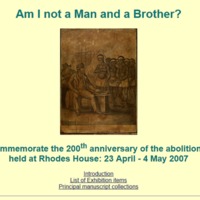
Am I Not a Man and a Brother?
‘Am I Not a Man and a Brother?’, an online exhibition to mark the bicentenary, was launched by the Bodleian Library of African and Commonwealth Studies at Rhodes House. Some of the items were also on view in an exhibition at Rhodes House in April and May 2007. The exhibition included manuscripts and books from the Library, among them the manuscript journal of Rev. James Ramsay, who wrote and worked against slavery after seeing for himself the conditions on board a slave ship while a Royal Navy surgeon. Also exhibited were related artefacts from the collection of Franklin Smith, including a tobacco jar and a clay pipe bowl, both in the shape of the head of a slave (indicating that their owners may have been slave owners), and the late 18th-century engraving of a slave market in the West Indies, published by an anti-slave trade body.
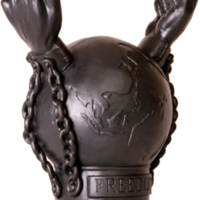
Abolition of the Slave Trade Act Commemorative Exhibitions
Nottingham Castle Museum held two exhibitions in 2007. Inspired by the anti-slavery medallion produced by Josiah Wedgwood in the 1790s, a group of young people from Nottingham’s African Caribbean community worked with artist Katherine Morling to explore issues surrounding slavery and the representation of black people in art. The group worked under the name Sankofa. The ceramic Globe of Freedom was fired at the Wedgwood factory in Staffordshire, and was displayed at Nottingham Castle Museum alongside the Wedgwood medallion. The word ‘FREEDOM’ is impressed on one side and ‘EQUALITY’ impressed on the other. A replica sculpture is still used as part of a handling collection loaned to schools and community groups in the Nottingham region. A second exhibition, in collaboration with the Open University in the East Midlands, looked at the British slave trade using slave narratives, telling the story of three survivors of slavery: Mary Prince, Robert Wedderburn and Quobna Ottobah Cugoano.
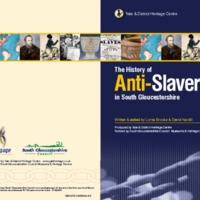
Impact: A history of anti-slavery in South Gloucestershire
This exhibition and booklet were produced as part of South Gloucestershire's Engage 2007 project, in partnership with Yate and District Heritage Centre. Both the exhibition and booklet explored local connections with the history of slavery and anti-slavery in South Gloucestershire. Links identified included the career of Robert Jenkinson of Hawkesbury (later Prime Minister Lord Liverpool), the Caribbean plantations of the Codrington family, the campaign efforts of abolitionist Joseph Sturge and, looking further back in history, St Wulfstan's attempts to abolish the trade in slaves to Ireland in the 11th century. The booklet was written and edited by Lorna Brooks and David Hardill. The exhibition toured the local area, including Thornbury and District Museum, pictured here.
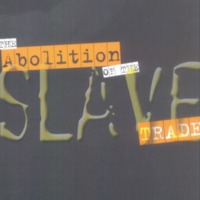
The Abolition of the Slave Trade
Kirklees Council ran a range of events in 2007, focused on local connections with slavery and abolition. Kirklees Civic Sunday was the official commemoration at Huddersfield Parish Church, with a performance by a local gospel choir and a presentation by actors as historical characters. The links between Yorkshire and the Caribbean were also explored: 8,500 people of African-Caribbean descent live in the borough of Kirklees. Events such as the Jamaica National Independence Cultural Festival, Deighton Carnival and Huddersfield Carnival celebrated African and Caribbean culture. Part of the Kirklees programme was to host the Equiano Project's touring exhibition at the Hudawi Centre in Huddersfield. The Centre went on to name one of its rooms after Equiano. Other events included talks from historians, including Richard Reddie and Paul Crooke, church services, choir concerts and theatre productions.
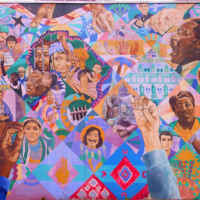
Freedom Quilt Mural
In 1988 David Fichter, with the help of volunteers, painted the Freedom Quilt Mural on the side of the American Friends Service Committee Building in Atlanta, Georgia. The mural was created as part of the Rainbow Coalition events during the 1988 Democratic National Convention. In February 2015 the building, owned by Georgia State University, was torn down – taking the mural with it. The quilted mural is thematically focused on non-violent heroes of history that struggled for justice and peace. It includes the faces of Mubarak Awad, Nelson Mandela, Winnie Mandela, Desmond Tutu, Oscar Romero, Rogoberta Menchu, Leonard Peltier, Andrew Goodman, Fannie Lou Hamer, Daniel Berrigan, Martin Luther King Jr., Rosa Parks, Mahatma Gandhi, and Lucretia Mott. It also includes the antislavery figures of Frederick Douglass and Harriet Tubman. Tubman points towards the North Star. Multi-racial hands stitch the quilt together, joining heroes (both famous and unknown) from all strands of history.
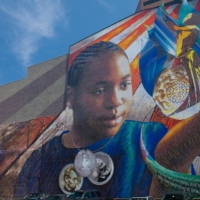
Lincoln Legacy
This large mural by Joshua Sarantitis, Lincoln Legacy, can be read from left to right, moving from Africa to America. The shape of Africa adorns the backdrop until the wooden boards of the slave ship transform into the American flag. Around the young child’s neck are three medallions: Abraham Lincoln’s face, Josiah Wedgwood’s abolitionist icon “Am I Not a Man and a Brother,” and Frederick Douglass' face. Made up of over 1 million glass mosaic tiles, it is the largest Venetian glass tile mural in Philadelphia at over 10,000 square feet. Located a block away from the Liberty Bell and Independence Mall, it is one of the few murals to be created in Philadelphia’s wealthier districts.
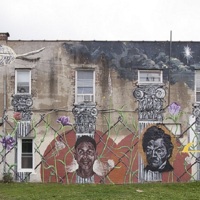
I Am, Yo Soy/Wall Therapy
As part of a Rochester WALL\THERAPY mural project in 2013, muralist Lunar New Year used Trayvon Martin, a young Frederick Douglass, and a local resident called Christopher to depict three possible paths of African American manhood in his mural I Am/Yo Soy. The young boy on the edge of the mural pleads to the North Star in the sky in a position that echoes Josiah Wedgwood’s famous 18th-century "Am I Not a Man and a Brother" medallion. An older version of Douglass then sits on the right side on the mural, as the only figure beyond the real and painted chain link fences.Lunar New Year, who is an Ecuadorian American Newark-based artist, explained that the mural is about “the history of institutionalized injustice in the USA… Injustice forged Frederick Douglass’s character, robbed Trayvon Martin of his life and [it] is up to us, to dictate what future awaits for young 7 year old Christopher from Rochester.”
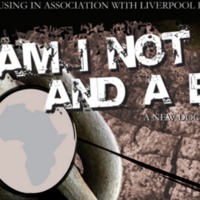
Am I Not a Man and a Brother?
Am I Not a Man and a Brother? was a piece of documentary theatre devised by Reveal Theatre Company in partnership with North Staffordshire Racial Equality Council. It used stories and testimony from the African Caribbean community in Stoke-on-Trent and North Staffordshire, interwoven with historical and contemporary slave stories. The play was produced by Robert Marsden and Julia Barton. The production was launched at the Stoke-on-Trent Racial Equality Council - where it was performed to the local people who had contributed their stories and was accompanied by a performance by a local Black choir - and then toured to venues in Bristol, London and Liverpool.